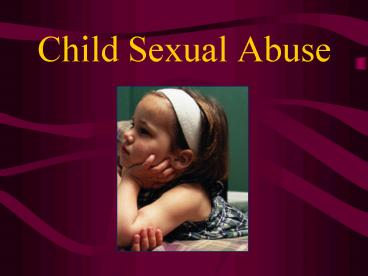Child Sexual Abuse - PowerPoint PPT Presentation
1 / 14
Title:
Child Sexual Abuse
Description:
The employment, use, persuasion, inducement, enticement, or ... Innocent kissing. Mouth to mouth kissing. Exposing or undressing. Observing while toileting ... – PowerPoint PPT presentation
Number of Views:253
Avg rating:3.0/5.0
Title: Child Sexual Abuse
1
Child Sexual Abuse
2
Responses to text
3
Definitions of Child Sexual AbuseNational
Clearinghouse for Child Abuse and Neglect
Informationhttp//nccanch.acf.hhs.gov/index.cfm
- The employment, use, persuasion, inducement,
enticement, or coercion of any child to engage
in, or assist any other person to engage in, any
sexually explicit conduct or simulation of such
conduct for the purpose of producing a visual
depiction of such conduct or - The rape, and in cases of caretaker or
interfamilial relationships, statutory rape,
molestation, prostitution, or other form of
sexual exploitation of children, or incest with
children.2
4
Continuum of Abuse Grooming Behavior in child
sexual abuse
- Nonsexual game playing
- Games involving touching
- Innocent kissing
- Mouth to mouth kissing
- Exposing or undressing
- Observing while toileting
- Touching when undressed
- Fondling private parts
- Has child touch private parts
- Penetration with objects
- Sexual penetration
- Taking sexual photos
- Threatening to injure
- Injuring during sex
5
Child Sexual Abuse Perpetrators Victims
Wallace, 2005
- Family members 47
- Acquaintances 40
- Strangers 8 10
- High risk age is 4 9 years
- Sexual abuse generally ends by 14 years
6
Finkelhors Theory of Preconditions for Abuse
Wallace, 2005
- Motivation to abuse sexually
- Emotional congruence satisfying an emotional
need by the behavior - Sexual Arousal child is the source of the
arousal - Blockage alternative forms are unavailable or
less satisfying - Overcoming Internal Inhibitors
- Inability of the offender to identify with the
needs of the victim - Use of alcohol or drugs
- Use of child pornography
- Existing psychosis
- Weak criminal sanctions
7
Finkelhors Theory of Preconditions for Abuse
Wallace, 2005
- Factors Predisposing to Overcome External
Inhibitors - Factors outside the control of the offender (e.g.
amount of supervision the child receives, unusual
living/sleeping arrangements, lack of a parental
figure) - Factors Predisposing to Overcome Childs
Resistance - Victims ability to resist sexual advances (e.g.
naïve, emotionally deprived, trusting of
offender)
8
Highlights of the Chapter
- Reliability
- Secrecy of sexual abuse
- Varying definitions of abuse
- Population sampled
- Differing research methods
- Prevalence vs. Incidence
- Incidence number of reported abuse cases
- Prevalence number of known cases
- Estimated 8 38 of girls and 4 15 of boys
are abused before age 18.
9
Highlights continued
- Difference between childhood sexual exploration
and abuse - Text says 5 years, Texas Penal Code says 3 yrs
- Severity of Abuse
- Severity of Abuse
- Degree of closeness in relationship b/w victim
and perpetrator - Length of time abuse occurs
10
Physical Indicators of Abuse Wallace 2005
- Difficulty walking or sitting
- Torn, stained, or bloody underwear
- Genital/anal itching, pain, swelling or burning,
- Genital/anal bruises or bleeding
- Frequent urinary tract or yeast infection
- Pain on urination
- Poor sphincter control
- Venereal disease
- Pregnancy
- Chronic unexplained sore throat
- Frequent psychosomatic illness
- Loss of appetite
11
Other indicators of abuse Highlights continued
- Strongest childhood behavioral indicator is
age-inappropriate sexual knowledge and play - Strongest familial indicator may be excessive
jealousy by male caretaker of the social or
dating behavior of the child in the family - Indicators should not be taken as absolute
evidence of abuse, but should be indicators of
further exploration
12
Highlights continued
- Medical model
- Diagnoses linked to childhood abuse
- Post Traumatic Stress Disorder
- Acute Stress Disorder
- Dissociative Disorders
- Mood Disorders
- There has been movement away from pathologizing
victims of abuse
13
Other models Highlights continued
- Four-Factor traumagenic model (Finkelhor Brown)
- Traumatic sexualization
- Betrayal of faith and trust in an older person
- Powerlessness childs ability to choose
appropriately - Stigmatization childs belief about self based
on the judgment of self and others
14
Other models Wallace 2005
- Sexual Abuse and Levels of Adjustment (Hartman
and Burgess) - Preabuse Conditions sum of the victims
experiences and emotional make-up - Processing the Event relationship with the
molester, degree of violence, type of defensive
mechanisms used by the victim during the abuse,
and childs age influence the level of stress
during this stage - Disclosure The process of revealing the event
how the childs system responded to the
disclosure - Posttrauma outcome patterned responses to the
event how the family is adjusting to the event,
how the child is processing the memories of the
event































